Another PSU line from EVGA is not news, but expectation since this brand has one purpose in mind, to completely confuse buyers and reviewers with the dozens PSU lines that it has in its portfolio. The EVGA SuperNOVA G7 members come in four flavors and use an FSP platform.
EVGA has a strong presence in the PSU market and made a good name primarily thanks to the cooperation with Super Flower, one of the best PSU OEMs. EVGA has released some of the great PSU lines over the years, the G2, P2, and T2, which used Super Flower’s top-notch Leadex platform. We have reached up to the G7 line, and Super Flower has stopped providing platforms to EVGA from G3. I think EVGA’s biggest mistake was the termination of cooperation with SF. I am not sure what went down, but EVGA couldn’t find suitable successors for SF’s platforms, and I miss PSUs like the T2 1600. The latter was the favorite among world-class overclockers and was heavily utilized during the mining booms because of its vast power and reliability.
Back to the G7 line, besides the super-compact dimensions, with only 130mm depth, the interesting parts of these units are the exterior design and the power bars on the sides, which depict the load levels. These bars are like the signal bars in mobile phones. The more of them are lit, the higher the load the PSU delivers. EVGA calls them system load indicator bars, and they look cool.
Cybenetics Report- Manufacturer (OEM): FSP
- Max Power: 1000W
- Efficiency: Cybenetics Platinum (89-91%), 80 PLUS Gold
- Noise: Cybenetics Standard++ (30-35 dB[A])
- Form Factor: ATX12V v2.52
- Alternative Low Power Mode support: ✓
- Power 12V: 1000W
- Power 5V + 3.3v: 120W
- Power 5VSB: 15W
- Cooling: 120mm Fluid Dynamic Bearing Fan (MGA12012XF-O25)
- Modular Design: Yes (Fully)
- High Power Connectors: 2x EPS, 8x PCIe 6+2 pin (on 5x cables)
- Peripheral Connectors: 12 SATA (on 4x cables), 4x 4-pin Molex (1x cable), 1x FDD adapter
- Dimensions (W x H x D): 150 x 85 x 130mm
- Warranty: 10 years
Protection Features
| Protection Features | |
| OCP (Cold @ 25°C) | 12V: 99A (118.84%), 12.170V 5V: 31A (129.17%), 5.133V 3.3V: 30.1A (125.42%), 3.354V 5VSB: 4.2A (140%), 5.022V |
| OCP (Hot @ 41°C) | 12V: 97.2A (116.67%), 12.195V 5V: 29.2A (121.67%), 5.140V 3.3V: 28.5A (118.75%), 3.366V 5VSB: 4.3A (143.33%), 5.023V |
| OPP (Cold @ 24°C) | 1291.64W (129.16%) |
| OPP (Hot @ 44°C) | 1258.75W (125.88%) |
| OTP | ✓ (156°C @ 12V Secondary Side) |
| SCP | 12V to Earth: ✓ 5V to Earth: ✓ 3.3V to Earth: ✓ 5VSB to Earth: ✓ -12V to Earth: ✓ |
| PWR_OK | Proper Operation |
| NLO | ✓ |
| SIP | Surge: MOV Inrush: NTC Thermistor & Bypass Relay |
Over current protection is set correctly on all rails. The same goes for over power protection, with the unit shutting down before it reaches 1300W under both cold and hot operating conditions. The rest protection features are present and working correctly.
Part Analysis
| General Data | – |
| Manufacturer (OEM) | FSP |
| PCB Type | Double Sided |
| Primary Side | – |
| Transient Filter | 4x Y caps, 2x X caps, 2x CM chokes, 1x MOV |
| Inrush Protection | NTC Thermistor SCK-056 (5 Ohm) & Relay |
| Bridge Rectifier(s) |
2x
|
| APFC MOSFETs |
3x
|
| APFC Boost Diode |
1x
|
| Bulk Cap(s) |
2x Nippon Chemi-Con (420V, 470uF each or 940uF combined, 2,000h @ 105°C, KHE)
|
| Main Switchers |
2x Infineon IPP60R120P7 (600V, 16A @ 100°C, Rds(on): 0.12Ohm)
|
|
IC Driver |
1x Novosense NSi6602 |
| APFC Controller |
Infineon ICE2PCS02
|
| Resonant Controller | Champion CM6901T2X |
| Topology |
Primary side: APFC, Half-Bridge & LLC converter
Secondary side: Synchronous Rectification & DC-DC converters |
| Secondary Side | – |
| +12V MOSFETs | no info |
| 5V & 3.3V | DC-DC Converters: 6x Infineon BSC0901NS (30V, 94A @ 100°C, Rds(on): 1.9mOhm) PWM Controller(s): ANPEC APW7159C |
| Filtering Capacitors | Electrolytic: 5x Rubycon (3-6,000h @ 105°C, YXG), 3x Rubycon (1-5,000h @ 105°C, ZL) Polymer: 18x Nippon Chemi-Con, 6x NIC |
| Supervisor IC | Weltrend WT7527RA (OCP, OVP, UVP, SCP, PG) |
| Fan Controller | Microchip PICF15324 |
| Fan Model | Protechnic Electric MGA12012XF-O25 (120mm, 12V, 0.52A, Fluid Dynamic Bearing Fan) |
| 5VSB Circuit | – |
| Rectifier |
1x NIKO-SEM P1006BD (60V, 42A @ 100°C, Rds(on): 10mOhm) FET
|
| Standby PWM Controller | Power Integrations INN2603K |
The OEM of this unit is FSP, and the platform is overpopulated because of the tiny PCB. Identifying such small platforms is challenging, especially if you consider that I only have one sample of this model, which I want to keep in pristine condition in case I need to retest it, so no heavy desoldering is allowed. This is why I wasn’t able to recognize several vital parts. I wouldn’t say I like it when I am not able to analyze a platform fully, but I cannot fully desolder every PSU that enters the lab.
The soldering quality is good, and the parts that FSP used in this unit are of high quality. I found Japanese caps and a top-notch fan from Protechinic Electric, which will easily outlive the extended warranty. The platform’s modern design features a half-bridge on the primary side and an LLC resonant converter. On the secondary side, we find a synchronous rectification scheme for the 12V rail and DC-DC converters for the minor rails.
Load Regulation
Load regulation is within 1% on the major rails, which is satisfactory but not impressive.
Ripple Suppression
Ripple suppression is good, although some competing offerings perform notably better, especially at 12V.
Transient Response
Transient response at +12V and 5VSB is excellent and pretty good on the other two rails. Transient response is indicative of the PSU’s real-life performance, so it is among PSUs’ most important performance factors.
Hold Up Time
The hold-up time is long, and the same goes for the power ok signal’s hold-up time.
Timings
The PSU supports Alternative Low Power Modes, which the ATX 3.0 spec requires.
Inrush Current
Inrush current is on the high side with both voltage inputs.
Efficiency Measurements Normal Loads
With normal loads, this FSP platform shows its teeth to the competition, achieving first place with 115V and 230V input.
Efficiency Measurements Light Loads
With light loads, the G7 shows signs of weakness since it cannot follow several competing offerings.
Efficiency Measurements Ultra Light Loads
With a 2% load, the unit barely meets the recommended 70% limit.
Average Efficiency 5VSB
The 5VSB rail is not as efficient as I expected.
Vampire Power
Vampire power should be below 0.1W with 230V input.
Average Efficiency
The average efficiency is sky-high, putting this PSU in the Platinum category in the Cybenetics scheme.
Average PF
The APFC converter has decent performance with 115V input, and there is room for improvement with 230V.
Average Noise
The compact dimensions and the ten-year warranty don’t allow for a more relaxed fan-speed profile. It is better to be on the safe side.
Noise Map @ 28-32 °C
The passive operation lasts long under normal operating temperatures, and the load on the minor rails doesn’t seem to affect it. There is a short period where the PSU’s fan operates at high speeds to remove the heat from the internals before it settles down in the 25-30 dBA range. The 30 dBA mark is passed with higher than 700W loads, and with above 760W, the unit’s fan exceeds 35 dBA. Lastly, the unit enters the 40-45 dBA range with anything above 850W.
Overall Performance
The 1000 G7 tops the performance scores, but it cannot take the lead from the Corsair RM1000x (2021), which increases the performance gap with 230V input. The performance increase over the 1000 G5 model, which was by FSP also, is notable. Another interesting fact is that the 1000 G3 achieves third place in the 115V graph (I haven’t tested it with 230V), showing that it still is a considerable force, despite its older Leadex platform.
Epilogue
EVGA’s persistence on FSP finally paid off, and the G7 line looks good. The 1000 G7 achieved the second best overall performance in my charts, losing only to the top-notch Corsair RM1000x, with a slight difference at 115V and a more significant performance gap at 230V. From G5 (FSP) and G6 (Seasonic), we reached G7. Hopefully, EVGA will relax a bit now that performance is up to the expected levels since so many lines create confusion. It is good not to get stuck to a single OEM, but trying most of them is crazy, and this is what EVGA seems to do the last years after it broke its relations with Super Flower. Speaking of Super Flower, I hope to see their platforms used again by a significant vendor since, as you saw in the performance graphs, the six-year-old G3 unit is still close to the performance of the G7 and it takes the lead from strong models like the Seasonic Prime Gold 1000 and the Asus Rog Thor with similar capacity.
You cannot go wrong with the 1000 G7, a tiny power factory, thanks to its only 130mm depth. The build quality is high, and the ten-year warranty provides a long peace of mind that many users will appreciate. The only major con is the lack of a PCIe 5.0 connector. I expect FSP and EVGA to rectify this soon and probably provide the corresponding cables to users who bought this model’s initial version. Given the controlled power spikes of the 3090Ti, I am not sure if the extreme ATX 3.0 requirements in transient loads are essential. We will only find out this once the new generation GPUs are out.
Buy it here- Full power at 47 degrees Celsius
- High overall performance
- Properly set protection features
- High build quality
- Efficient
- Above 70% efficiency with a 2% load
- Good transient response
- Long hold-up time
- Tight enough load regulation
- Good ripple suppression
- Tiny dimensions (130mm depth)
- Two EPS and eight PCIe connectors
- High-quality FDB fan
- Compatible with the alternative sleep mode
- Fancy system load indicators
- 10-year warranty
- Lacks PCIe 5.0 connectors
- Inrush currents could be lower (especially with 115V)
- Relatively low PF readings with 230V input
- 5VSB rail’s efficiency should be higher
- More than 0.1W vampire power with 230V input
- Short distance between the peripheral connectors
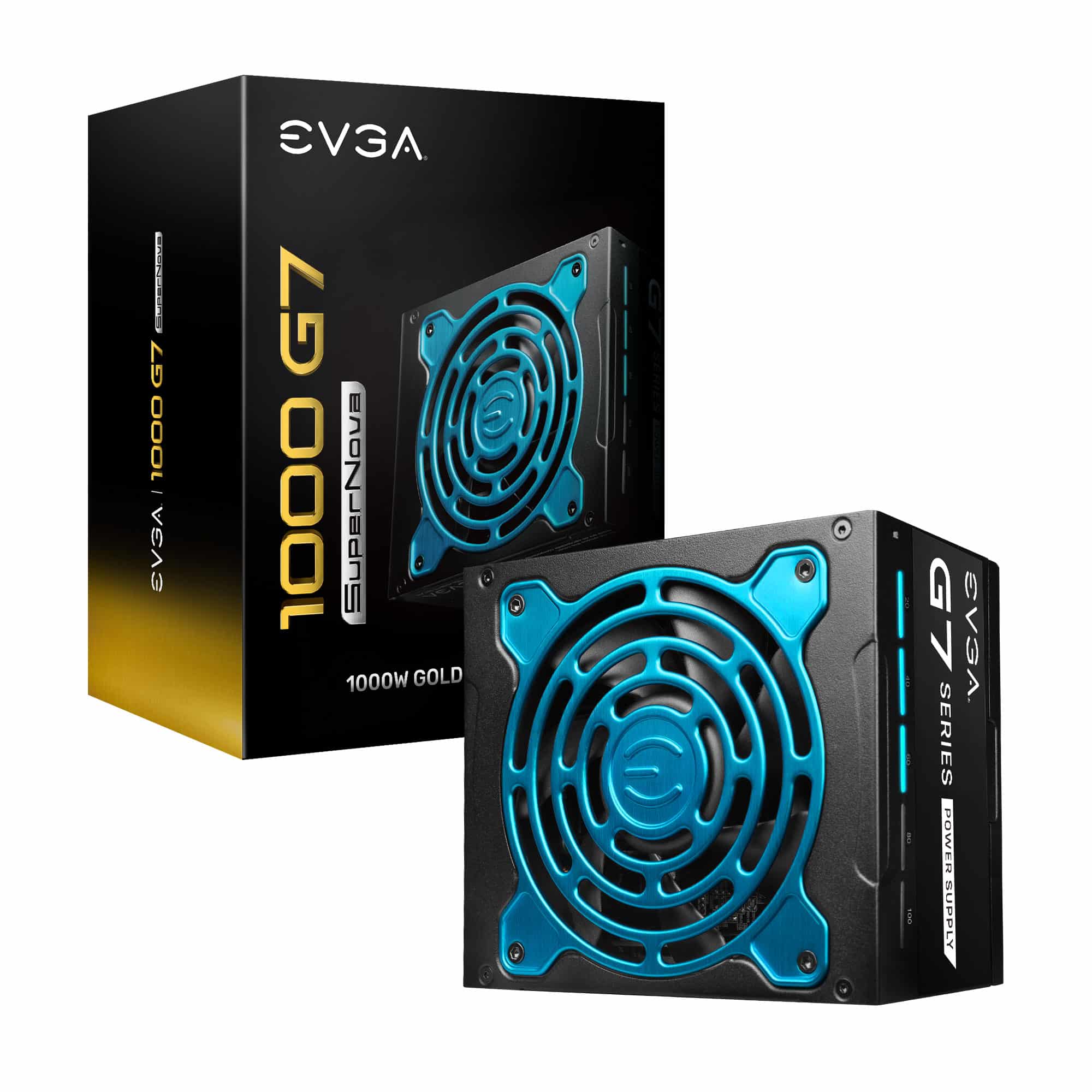

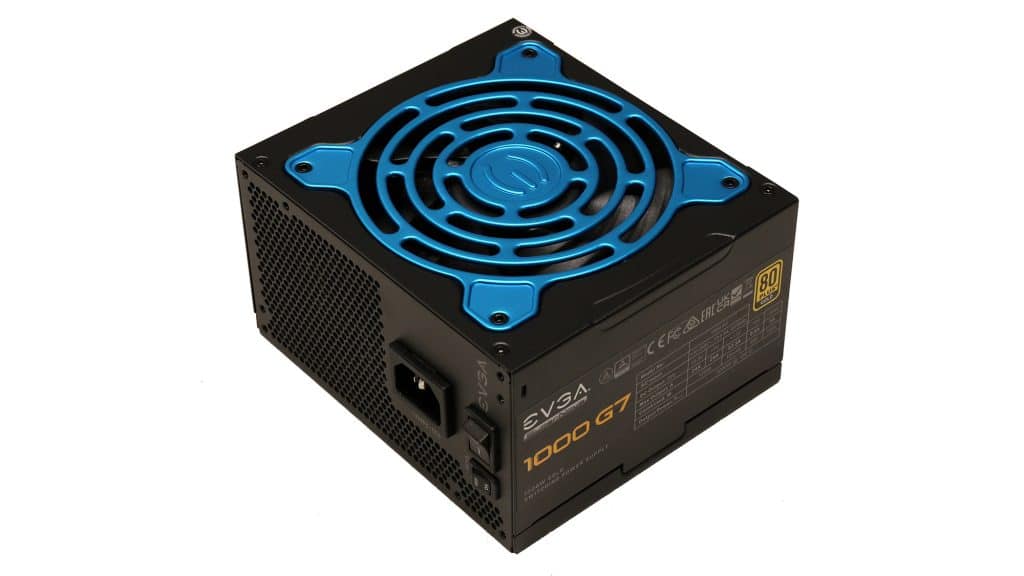
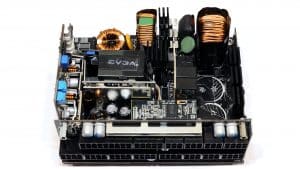
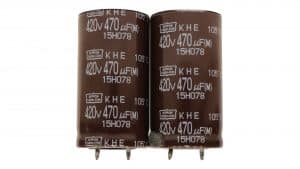
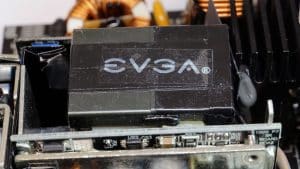


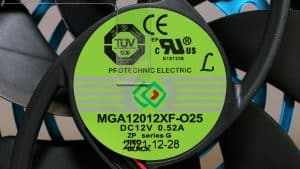
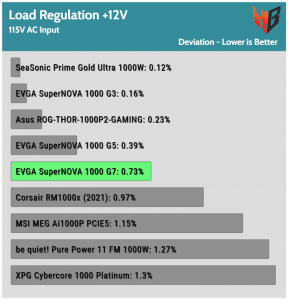

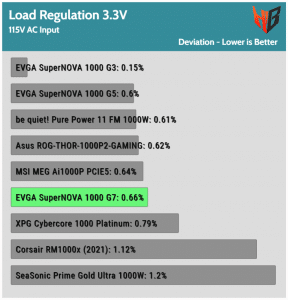
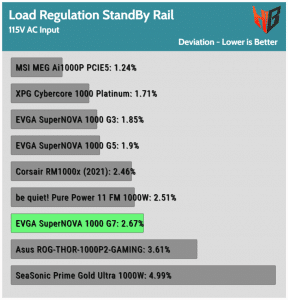
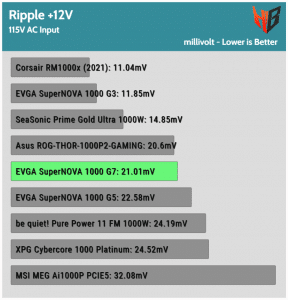
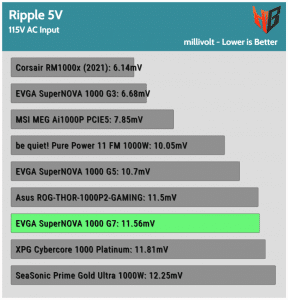
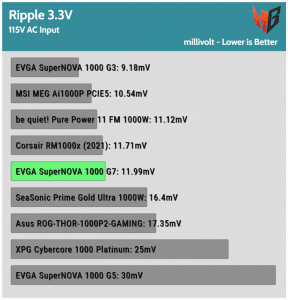
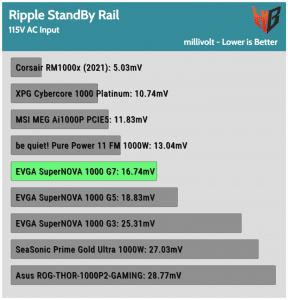

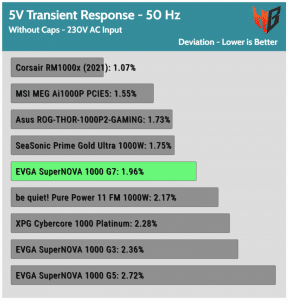
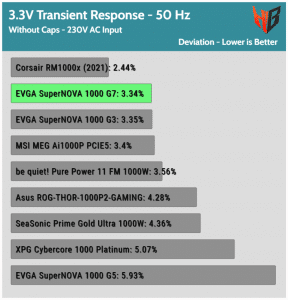
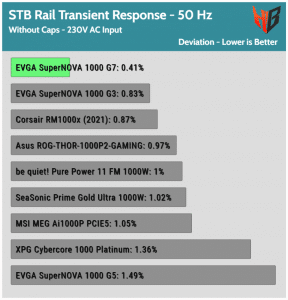
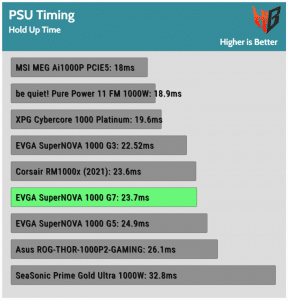


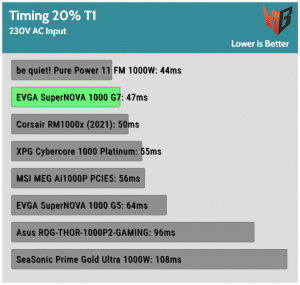
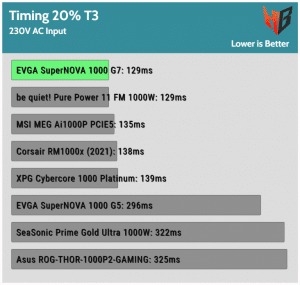
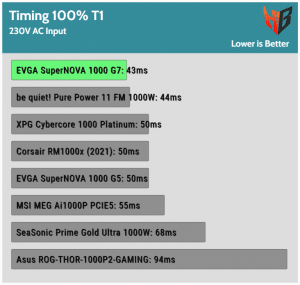
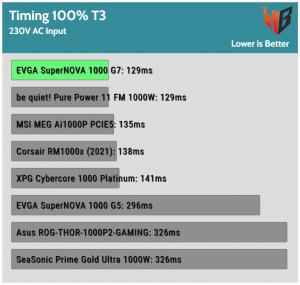
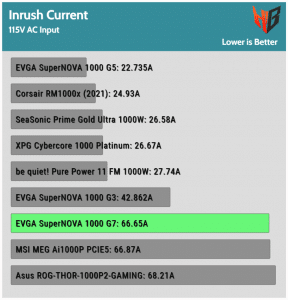

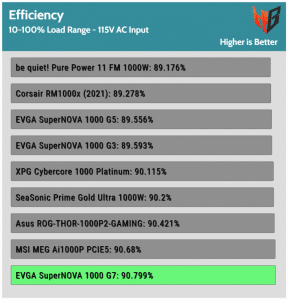
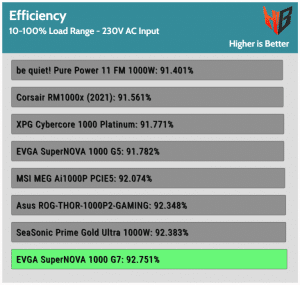

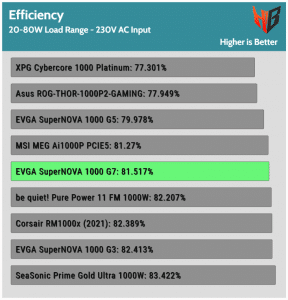

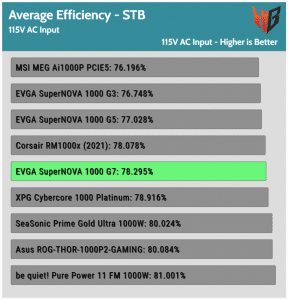
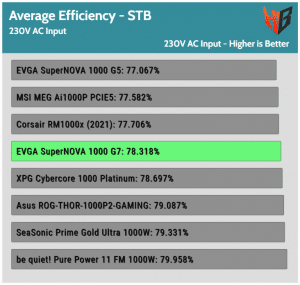
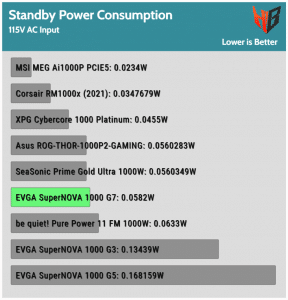
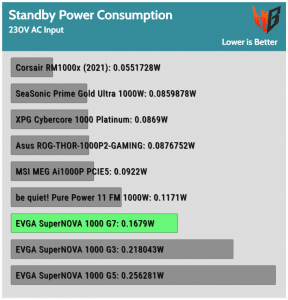
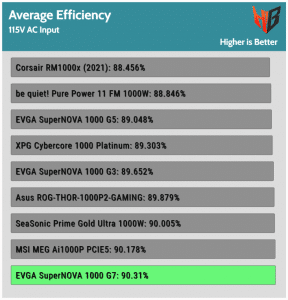
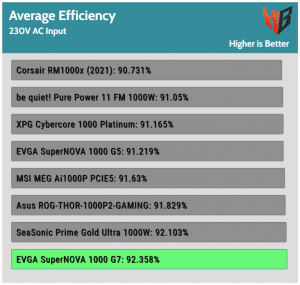

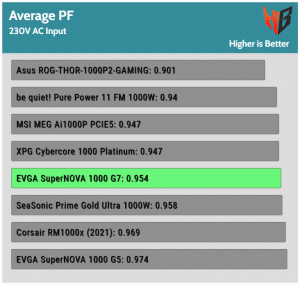

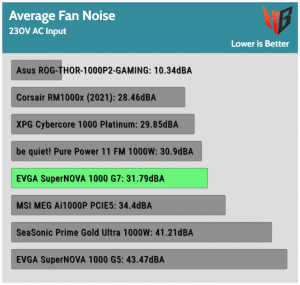


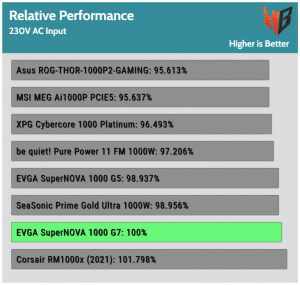
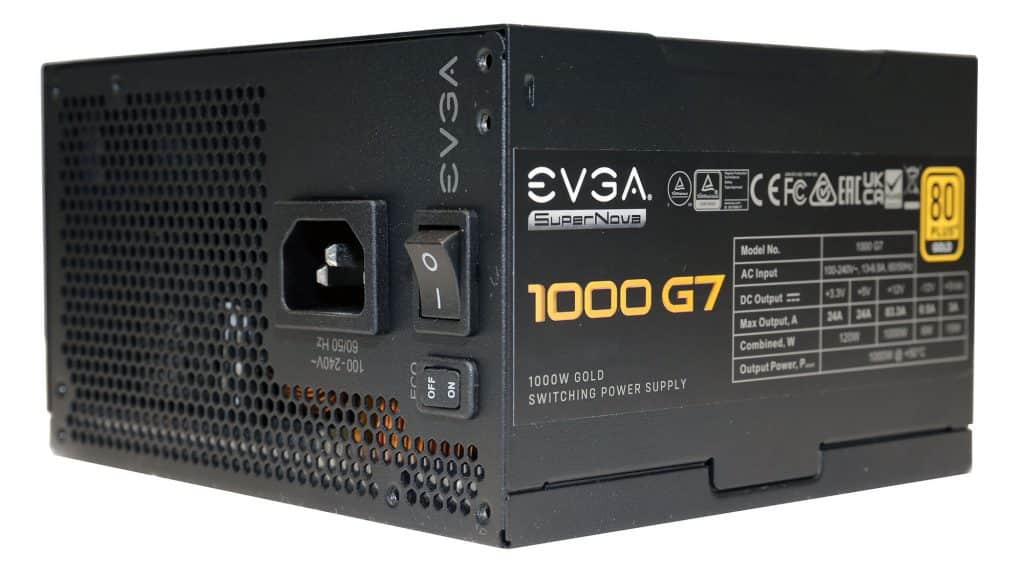
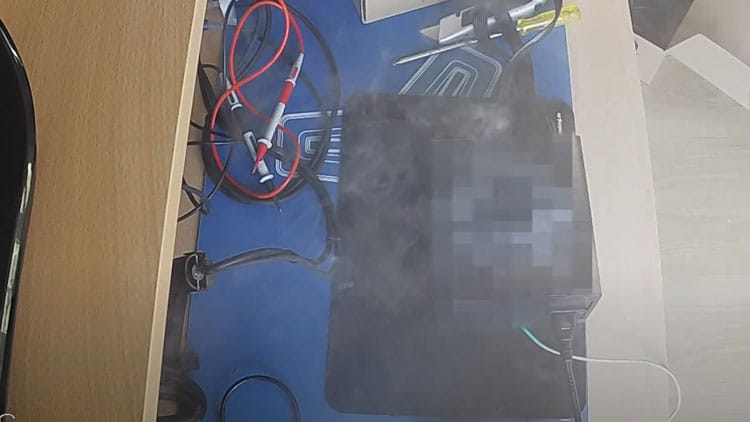
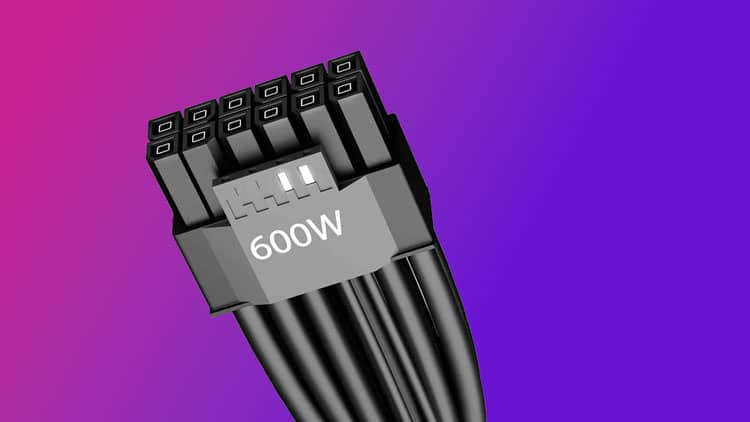
I’m really torn on going with either the 850 or 1000w g7 over the older Supernova t2 850. I’d like the savings of size in my case Fractal Torrent compact to help stow the cables a bit.
Would you recommend to buy EVGA G5 or EVGA GT? both 1000w
I would go with the G5 if I had to choose between these two.
Hi Crmaris I heard recently that the new RTX 40 series will demand and ATX 3.0 PSU power cable.
Would you talk about this in a video?
Also does the EVGA G7 support that 3.0 cables?
Hi! Nvidia stated that there is no need for ATX 3.0 and PCIe 5.0 PSUs for its 4000 series. This means that every brand can offer PCIE 12+4 cables to existing PSUs without worrying about issues with the upcoming cards.
nice👍
Would you recommend to buy EVGA G3 or EVGA G7? both 1000w
G7
Thanks.
Honestly I enjoyed watching your reviews on PSUs.
the details you provide.
Thank you 🙂
how did u get a sample for the msi meg ai1000p? could publish its reviews?
seems to be the first pcie5.0 and atx 3.0 psu
I have my sources 🙂 I will soon make a review out of it. yes.
wow man.. u really are one of the best psu reviewers out there.. please do a seasonic px, super flowers, asus rog thor 2s and perhaps the fsp hydro ptms…
Will do more on this site soon. From September I will be on fire 🙂
Hello,
Would you recommend the G7 over the G6 ?
Also any news about testing the P3 series 1000w-1200w ?
Thanks
Both are very good. I would probably go for G7. I don’t have any P3 samples, sorry.